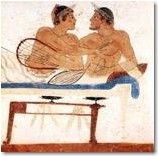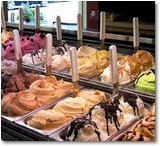The Summer In Italy Newsletter

Experiencing Greece... in Italy
It may surprise you to learn that centuries before the Romans left their mark on southern Italy, the Greeks had thriving trade routes and well-established, cosmopolitan cities that carried on all the culture and learning of ancient Greece.
Naples started life as Neopolis (New City). Paestum was known as Poseidonia before the Romans arrived and renamed it, but its impressive temples and painted tombs are monumental reminders of Greek domain. Numerous other towns in the area trace their names to Greek origins, like Agropoli, Velia and Palinuro.
Even today there are echoes of Greek in the inhabitants’ names, and it’s not uncommon to see Ulisse, Diana, and Atena inscribed on name plates throughout the Cilento area.
The splendid wines produced by mostly-small, family vineyards are heritage varieties traced back to antiquity, and believed to have been introduced by the Greeks. Vintages such as Piedirosso, Greco di Tufo and Aglianico (whose name derives from “Hellenic”) are prized around Italy for their unique qualities.
All along the Campania coast there are places that harken back to Greek legends- and legendary writers. One example is the pretty lighthouse near San Marco di Castellabate, which sits on a tiny island just off the rocky shore. Its mythical origin dates back toa bout 800 BC but is recounted by locals like a more modern historical happening. Punta Licosa derives its name from the Greek 'Leucosia', who is said to have been one of the three sirens (or mermaids) mentioned by Homer in his epic Odyssey, whose songs lured sailors to shipwreck on the rocks. Odysseus had to be tied to the mast to keep from succumbing to their melodic allures. The mythical Leucosia, after failing to bring destruction to Odysseus, was thrown into the abyss of the sea and washed up on an island, which was named after her...hence, Punta Licosa.
Today the lighthouse stands guard and keeps sailors from shipwrecks- by sirens or storms, and to remind visitors that Greece left many distinctive marks on southern Italy.

Italian Wisdom
"Patti chiari, amicizia lunga"
(Clear agreements make for long-lasting friendship).
Culture Shock
Very few Italian homes have screens at their windows. If you ask any Italian mama, she will tell you that the screens make her feel 'locked in', that they block light and fresh air, and that she'll rather make friends with mosquitoes than tolerate screens. As a result, there is a florid market of bug repellents, which you can buy at any supermarket and often even at Tabacchi shops. The debate on whether the air is fresher when you don't use screens and spray some chemicals to keep bugs out is still open.

Hot for Gelato
When summer turns sultry, Italians turn to the national passion, gelato, to ease the heat. While gelato (which means “frozen” in English) is frequently translated as “ice cream”, there are some important differences in the delicious delicacy found in the Old World, especially the “cream” part! Gelato contains far less cream –and therefore butter fat-than ice cream, which traditionally weighs in with 15-25% fat. Gelato, on the other hand, boasts an average of 4-8% fat, with many fruit-based concoctions bearing zero fat.
Gelato in some form or another has been enjoyed on the peninsula since Roman times, when snow was sprinkled with juice or syrups for flavor. Rediscovered during the Renaissance, the Medici resurrected frozen treats for their fancy fetes. These ices evolved to include custard and fruit, becoming ever more elaborate, and no Florentine banquet was complete without them. In those days, gelato remained firmly in the domain of the wealthy.
But it was from the sizzling isola of Sicily that gelato was popularized publicly. A fisherman named Procopio dei Coltelli introduced the first machine to manufacture gelato on a larger scale. He opened the world’s first gelateria in Paris in 1686, still in operation today as the oldest café on record. His gelato was an instant hit, and the uniquely Italian treat spread throughout Europe.
Gelato is dense and creamy but delivers a pure, intense flavor because it is kept at a higher temperature than ice cream. The combination of less fat (which coats the tongue and masks flavor), and the use of fresh ingredients instead of artificial flavoring agents also allow the taste to fully burst forth. Dairy-based flavors use whole milk and fresh nuts, real chocolate, or cooked custard (zabaglione or crema) to delivery creamy sensations. Fruit-based gelato is actually a sorbet, utilizing an array of fresh seasonal fruits with sugar and water to make a refreshing zing of cold goodness.
One taste is all it takes to get you hooked, but luckily the gelateria lets you combine two or three flavors on cone to give you a wider sampling. No wonder everyone is hot for gelato when the heat kicks in!
You have to be Italian when...
...you won't remove the plastic cover from your new chairs until it's completely torn. And when you do you are very sad about it.

 Amalfi Coast
Amalfi Coast Sorrento Coast
Sorrento Coast Tuscany
Tuscany Cilento National Park
Cilento National Park Lake Como
Lake Como Rome and Latium
Rome and Latium Umbria
Umbria Capri and Ischia
Capri and Ischia Venice
Venice Puglia (Apulia)
Puglia (Apulia) Liguria
Liguria Sicily
Sicily Lake Maggiore
Lake Maggiore Lombardy
Lombardy Sardinia
Sardinia Lake Garda
Lake Garda Abruzzo and Marche
Abruzzo and Marche Calabria
Calabria